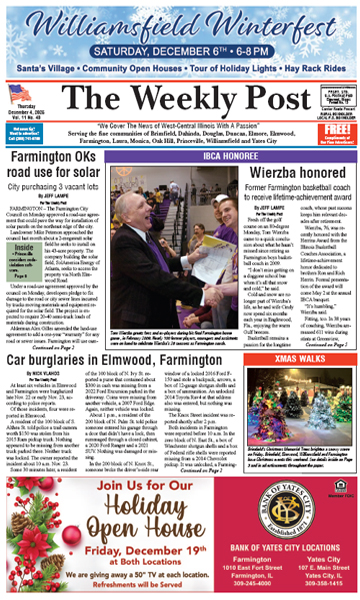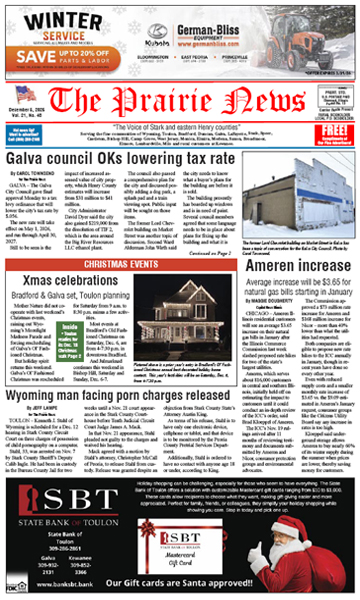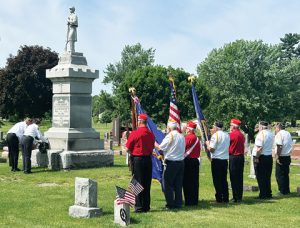Sick whitetail tests positive for CWD
By JEFF LAMPE
For The Weekly Post
The bad news that deer hunters and recreational landowners in Peoria County had long expected finally arrived over the weekend, when the state announced a sick 2-year-old deer tested positive for chronic wasting disease.
The deer came from a location 5 miles west of Edwards and 4 miles northeast of Trivoli, just west of Eden Road. In other words, way too close to home.
The CWD diagnosis is bad for many reasons. The neurological disease, which is akin to mad cow disease, is always fatal for deer. CWD is expected to have a long-term impact on whitetail populations in Illinois – even though it is not as widespread as epizootic hemorrhagic disease, the EHD some folks confuse with CWD.
Bugs spread EHD. Prions are responsible for CWD. In both cases, hunters are recommended to avoid eating diseased deer.
Then there are the paid sharpshooters. When CWD was first discovered in northern Illinois in 2002, the Department of Natural Resources initiated an aggressive management approach to slow the spread of the disease.
While the science may have been solid, it has been very unpopular to pay sharpshooters to kill deer over bait piles, which are illegal for hunters to use. The program didn’t sit well with most – not casual observers, not recreational landowners and certainly not hunters, many of whom said it had a negative impact on their experience.
It didn’t matter to most that DNR officials said culling was needed and made Illinois “a model for other states,” as IDNR Director Natalie Phelps Finnie said in a press release.
Theories to the contrary abound online, where it’s clear the days of trusting government are over.
The only silver lining in this discovery is that the state will not enlist sharpshooters in Peoria County. So says Jayette Bolinski, a spokesperson who said the DNR has changed its CWD strategy for 2025-29.
“We will not be shooting in Peoria County,” she said. “We will rely on hunter harvest.”
That means you can expect more permits for sale in Peoria County and in other newly emerging counties across the southern two-thirds of the state, according to the new management program. How effective that will be is open to debate, since firearm seasons are increasingly less important in the overall deer kill.
Under the new program, DNR is also ending sharpshooting in seven northern counties where the disease shows up in greater than 5% of the deer tested.
That seems like a wise decision that may also be motivated by a lack of funds to support expansion now that CWD is in 25 counties.
Paid shooters will cull deer in Putnam and Marshall counties, two other new locations where the disease showed up this year. The state will also open check stations in those counties to better gauge distribution of the disease. Sharpshooting efforts will take place by obtaining permission from a landowner after the regular hunting season ends.
That does little to help neighboring landowners who don’t want to see their deer herd thinned. Anyone who owns land or has tried to buy land is aware that Illinois ground is expensive. That’s true mostly due to the corn and beans it grows, but also to the scarcity of recreational ground that supports wildlife.
In other words, this is a big money issue – even bigger in Adams County, the fourth to have a deer test positive for CWD. Thay discovery was unexpected, because the pattern over the past two decades has been for a slow but steady spread of CWD to the south and west. How it jumped to Adams County is uncertain.
What impact CWD will have on the outfitting industry in that county – part of the nationally known deer hunting Golden Triangle – is yet to be seen. Bolinski said Adams County will not be subject to sharpshooting but will be opened to the special CWD firearm season in January.
Worth noting is that the natural expansion of CWD makes its discovery in Knox, Stark and Fulton counties a mere formality. Bolinski says sharpshooting will not take place in those counties either, with the emphasis shifting instead to increased hunter harvest.
No doubt we will learn more when DNR holds public meetings that are to be scheduled later this summer.
Contact Jeff Lampe at (309) 231-6040 or jeff@wklypost.com







